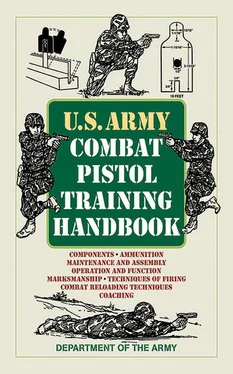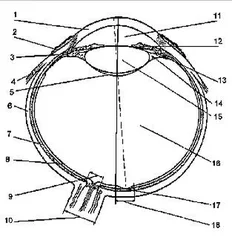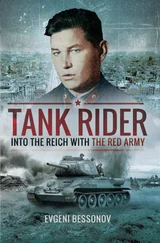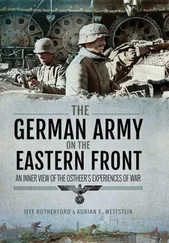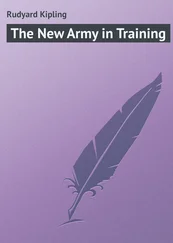(1) Traversing to the Left Side (Figure 2-20): The upper body turns to a comfortable position toward the left. The weapon is aimed to the left. Both elbows are bent with the left elbow naturally bent more than the right elbow.
(2) Traversing to the Front (Figure 2-21): The upper body turns to the front, and a standard unsupported kneeling position is assumed. The right firing arm is straight, and the left elbow is slightly bent.
(3) Traversing to the Right Side (Figure 2-22): The upper body turns to the right as both arms straighten out.
(4) Traversing to the Rear (Figure 2-23): The upper body continues to turn to the right as the left knee is turned to the right and placed on the ground. The right knee is lifted off the ground and becomes the forward knee. The right arm is straight, while the left arm is bent. The direction of the kneeling position has been reversed.
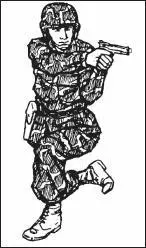
Figure 2-20. Traversing to the left, kneeling.
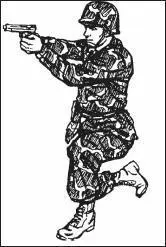
Figure 2-21. Traversing to the front, kneeling.
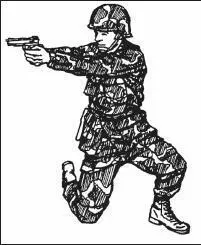
Figure 2-22. Traversing to the right, kneeling.

Figure 2-23. Traversing to the rear, kneeling.
(5) Traversing to the New Right Side (Figure 2-24): The upper body continues to the right. Both elbows are straight until the body reaches a point where it cannot go further comfortably. Eventually, the left hand must be released from the fist grip, and the firer is shooting to the right with the one-hand grip.

Figure 2-24. Traversing to the new right side, kneeling.
c. Training Method. This method can be trained and practiced anywhere and, with the firer simulating a two-hand grip, without a weapon. The firer should be familiar with firing in all five directions.
2-10. Combat Reloading Techniques
Overlooked as a problem for many years, reloading has resulted in many casualties due to soldiers’ hands shaking or errors such as dropped magazines, magazines placed in the pistol backwards, or empty magazines placed back into the weapon. The stress state induced by a life-threatening situation causes soldiers to do things they would not otherwise do. Consistent, repeated training is needed to avoid such mistakes.
NOTE:These procedures should be used only in combat, not on firing ranges.
a. Develop a consistent method for carrying magazines in the ammunition pouches. All magazines should face down with the bullets facing forward and to the center of the body.
b. Know when to reload. When possible, count the number of rounds fired. However, it is possible to lose count in close combat. If this happens, there is a distinct difference in recoil of the pistol when the last round has been fired. Change magazines when two rounds may be left–one in the magazine and one in the chamber. This prevents being caught with an empty weapon at a crucial time. Reloading is faster with a round in the chamber since time is not needed to release the slide.
c. Obtain a firm grip on the magazine. This precludes the magazine being dropped or difficulty in getting the magazine into the weapon. Ensure the knuckles of the hand are toward the body while gripping as much of the magazine as possible. Place the index finger high on the front of the magazine when withdrawing from the pouch. Use the index finger to guide the magazine into the magazine well.
d. Know which reloading procedure to use for the tactical situation. There are three systems of reloading: rapid, tactical, and one-handed. Rapid reloading is used when the soldier’s life is in immediate danger and the reload must be accomplished quickly. Tactical reloading is used when there is more time and it is desirable to keep the replaced magazine because there are rounds still in it or it will be needed again. One-handed reloading is used when there is an arm injury.
(1) Rapid Reloading .
(a) Place your hand on the next magazine in the ammunition pouch to ensure there is another magazine.
(b) Withdraw the magazine from the pouch while releasing the other magazine from the weapon. Let the replaced magazine drop to the ground.
(c) Insert the replacement magazine, guiding it into the magazine well with the index finger.
(d) Release the slide, if necessary.
(e) Pick up the dropped magazine if time allows. Place it in your pocket, not back into the ammunition pouch where it may become mixed with full magazines.
(2) Tactical Reloading .
(a) Place your hand on the next magazine in the ammunition pouch to ensure there is a remaining magazine.
(b) Withdraw the magazine from the pouch.
(c) Drop the used magazine into the palm of the nonfiring hand, which is the same hand holding the replacement magazine.
(d) Insert the replacement magazine, guiding it into the magazine well with the index finger.
(e) Release the slide, if necessary.
(f) Place the used magazine into a pocket. Do not mix it with full magazines.
(3) One-Hand Reloading, Right Hand .
(a) Push the magazine release button with the thumb.
(b) Place the safety ON with the thumb if the slide is forward.
(c) Place the weapon backwards into the holster.
NOTE:If placing the weapon in the holster backwards is a problem, place the weapon between the calf and thigh to hold the weapon.
(d) Insert the replacement magazine.
(e) Withdraw the weapon from the holster.
(f) Remove the safety with the thumb if the slide is forward, or push the slide release if the slide is back.
(4) One-Hand Reloading, Left Hand .
(a) Push the magazine release button with the middle finger.
(b) Place the weapon backwards into the holster.
NOTE:If placing the weapon in the holster backwards is a problem, place the weapon between the calf and thigh to hold the weapon.
(c) Insert the replacement magazine.
(d) Remove the weapon from the holster.
(e) Remove the safety with the thumb if the slide is forward, or push the slide release lever with the middle finger if the slide is back.
2-11. Poor Visibility Firing
Poor visibility firing with any weapon is difficult since shadows can be misleading to the firer. This is mainly true during EENT and EMNT (a half hour before dark and a half hour before dawn). Even though the pistol is a short-range weapon, the hours of darkness and poor visibility further decrease its effect. To compensate, the firer must use the three principles of night vision:
a. Dark Adaptation. This process conditions the eyes to see during poor visibility conditions. The eyes usually need about 30 minutes to become 90 percent adapted in a totally darkened area.
b. Off-Center Vision. When looking at an object in daylight, a person looks directly at it. However, at night he would see the object only for a few seconds. To see an object in darkness, he must concentrate on it while looking 6 to 10 degrees away from it.
Читать дальше
